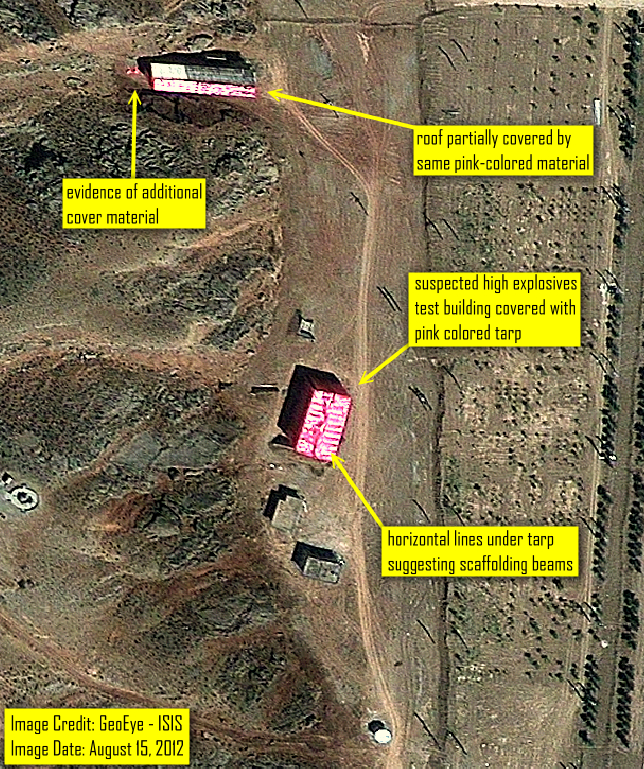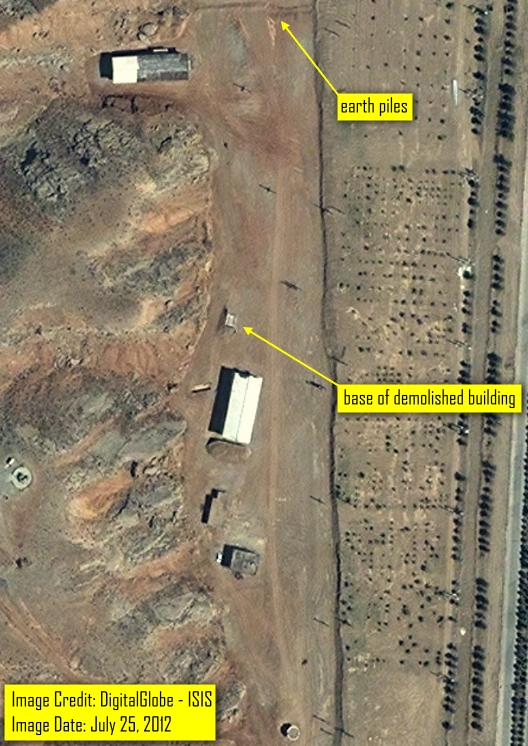Reports
New Phase of Suspect Activity at Parchin Site
by David Albright and Robert Avagyan
August 24, 2012
In an August 1, 2012 report, ISIS assessed that apparent cleanup activities at the Parchin site in Iran were complete because imagery showed what appeared to be the final result of considerable sanitization and earth displacement activity. A new GeoEye image dated August 15, 2012 shows that additional suspicious activity may be occurring at the building suspected of housing high explosive experiments related to the development of nuclear weapons and at an adjacent, northern building that may have also hosted suspect activities (figure 1). The new image shows what appears to be pink tent-like material over the two buildings. A Reuters article concurrently reported that “diplomatic sources said the building believed to be housing an explosives chamber - if it is still there - had been ‘wrapped’ with scaffolding and tarpaulin, hiding any sanitization or other activity there from satellite cameras.”
The latest satellite imagery clearly shows the suspected high explosive test building covered in a pink-colored material. A comparison with previous satellite images of the building shows that the size of the now covered building has visibly increased, especially in its height. In consultation with experts ISIS believes that the covering tarp is supported underneath by scaffolding which would account for the increase in size as well as for the horizontal lines appearing under the tarp (figure 1).
Similar activities appear to be taking place at the northernmost building at the site. Currently only part of the roof appears covered by the pink-colored tarp; however, similarly colored material is visible on the ground next to the building suggesting that it may soon be covered.
The purpose of covering the buildings could be to conceal further cleanup activity from overhead satellites or to contain the activity inside. Depending on how effective of a seal the tarp provides, the goal could be continue sanitizing the inside and outside of the building that is suspected to contain particles indicative of nuclear weapons development work. Alternatively tarps could provide a cover for the demolition of the buildings, or portions of them, while also containing the spread of potentially contaminated debris.
This new phase of activity at Parchin comes just before the September meeting of the IAEA Board of Governors. Given Iran’s refusal of access to the Parchin site and its refusal to discuss any other evidence of weaponization work, the IAEA may be unable to make further progress in addressing issues concerning the military dimensions of Iran’s nuclear program. ISIS reiterates its call made in its August 1, 2012 report that unless Iran demonstrates concretely that it is willing to address these issues, the Board should pass a resolution that refers this set of issues to the U.N. Security Council for further action, including the imposition of additional sanctions.

Figure 1. GeoEye satellite image from August 15, 2012 showing the suspected high explosives test building covered with a tent like material most likely supported by scaffolding. An adjacent building to the north also appears partially covered with the same material.

Figure 2. Satellite image from July 25, 2012 showing the results of extensive alterations undertaken at the suspected high explosives testing site, including the demolition of two buildings and major earth displacement activities.

 twitter
twitter